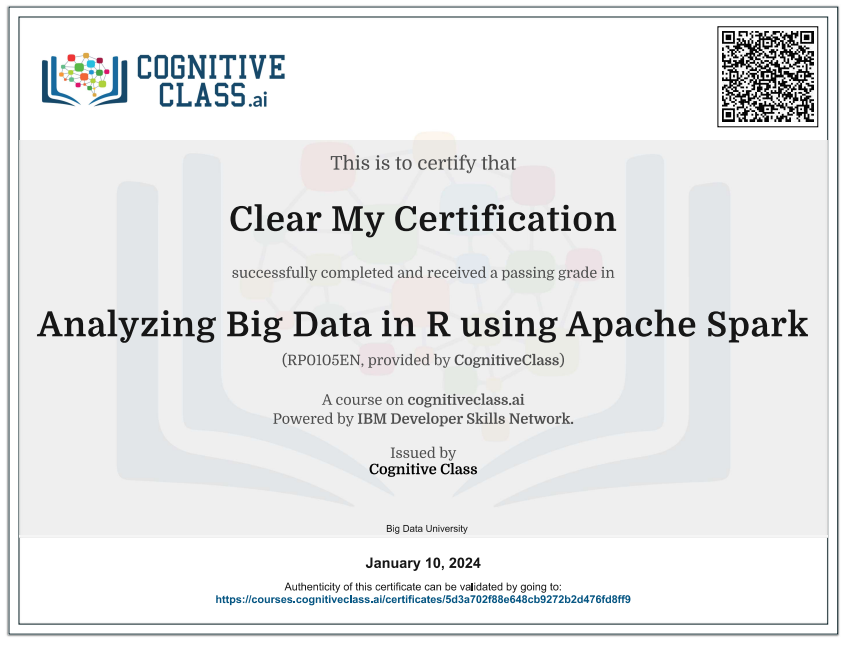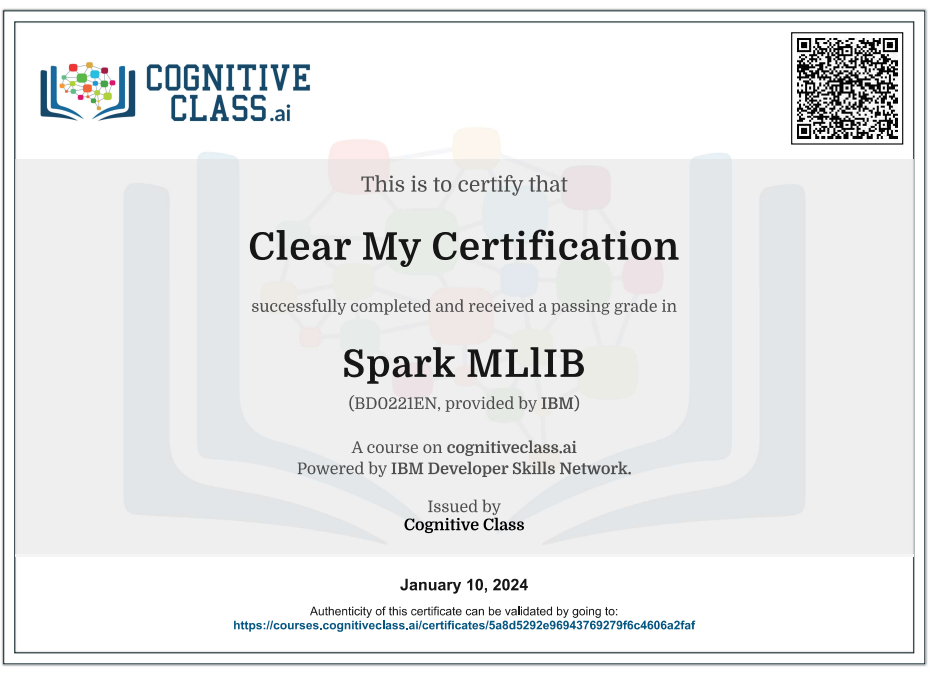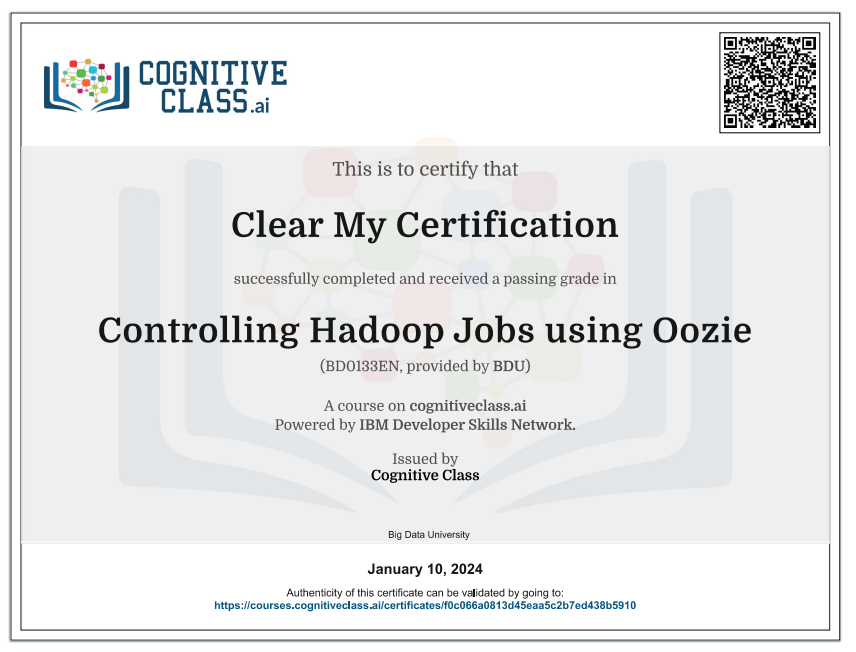Enroll Here: NoSQL and DBaaS 101 Cognitive Class Exam Quiz Answers
NoSQL and DBaaS 101 Cognitive Class Certification Answers

Modules 1 – Introducing NoSQL Quiz Answers – Cognitive Class
Question 1: Scalability is a reason for employing a NoSQL database. True or false?
- True
- False
Question 2: Which of the following is a category of a NoSQL database?
- KeyValue
- Document
- Graph
- BigTable
- All of the above
Question 3: A NoSQL database is slightly more costly than a standard RDBMS. True or false?
- True
- False
Modules 2 – Defining NoSQL Database Types, Options, and Use Quiz Answers – Cognitive Class
Question 1: Which type of NoSQL database is the simplest?
- Graph
- BigTable/Column-Family
- Key-Value
- Document
Question 2: In a document database, documents have a flexible schema where more than one document can share the same information. True or false?
- True
- False
Question 3: Column-Family databases are worse than Graph databases when dealing with large amounts of sparse data. True or false?
- True
- False
Modules 3 – Choosing a Data Layer for Your Application Quiz Answers – Cognitive Class
Question 1: Since NoSQL databases offer horizontal scalability, they generally work well within a cloud architecture. True or false?
- True
- False
Question 2: Since many NoSQL databases primarily operate within a cluster, they cannot meet high availability requirements. True or false?
- True
- False
Question 3: Due to the flexibility and ease of integration of many NoSQL databases, it is often unnecessary to assess the skill sets of those who are developing applications. True or false?
- True
- False
Modules 4 – Introducing Cloudant – A NoSQLDBaaS Quiz Answers – Cognitive Class
Question 1: Cloudant scales very well to large amounts of
- Data and Concurrent Users
- Concurrent Users
- Data
- None of the above
Question 2: What file format does Cloudant use to store documents?
- TXT
- ASCII
- JSON
- XML
Question 3: Data can be replicated within clusters to keep them synchronized without administration intervention. True or false?
- True
- False
Modules 5 – Getting Started with IBM Cloudant: A Hands-On Introduction Quiz Answers – Cognitive Class
Question 1: Database names should contain lowercase alphanumeric characters, and they are allowed to contain spaces. True or false?
- True
- False
Question 2: For each database, Cloudant creates a primary index and stores it in a T-Tree. True or false?
- True
- False
Question 3: Which of the following is a component of the Cloudant HTTP API hierarchy?
- Attachment
- Database
- Document
- Account
- All of the above
NoSQL and DBaaS 101 Final Exam Answers – Cognitive Class
Question 1: The term NoSQL refers to a family of databases that vary widely in style and technology. True or false?
- True
- False
Question 2: Which of the following is a characteristic of NoSQL databases?
- Fixed schemas are supported
- Datastores are non-relational
- The data model is always a set of tables
- All of the above
Question 3: What prompted the need for NoSQL databases?
- Companies could no longer afford to develop and host databases
- The dotcom boom in the late 90’s and early 2000’s
- Relational databases became obsolete
- All of the above
Question 4: Which of the following database solutions is NOT a NoSQL database?
- Oracle
- Mongo
- Apache CouchDB
- Riak
Question 5: In which of the following situations should you consider using a Key-Value NoSQL database?
- The database only needs to perform basic CREATE-READ-UPDATE-DELETE operations. The data to be housed is not highly related.
- The database will be housing sparse data sets or Big Data sets. There will be a need for compression or versioning control.
- The data is highly interconnected and business use-cases need to be able to trace relationships between data points.
- The database schema for insertions is not well-defined. The schema is likely to change over time and your solution needs to remain flexible.
Question 6: In which of the following situations should you consider using a Column-family NoSQL database?
- The database only needs to perform basic CREATE-READ-UPDATE-DELETE operations. The data to be housed is not highly related.
- The database will be housing sparse data sets or Big Data sets. There will be a need for compression or versioning control.
- The data is highly interconnected and business use-cases need to be able to trace relationships between data points.
- The database schema for insertions is not well defined. The schema is likely to change over time and your solution needs to remain flexible.
Question 7: In which of the following situations should you consider using a Document NoSQL database?
- The database only needs to perform basic CREATE-READ-UPDATE-DELETE operations. The data to be housed is not highly related.
- The database will be housing sparse data sets or Big Data sets. There will be a need for compression or versioning control.
- The data is highly interconnected and business use-cases need to be able to trace relationships between data points.
- The database schema for insertions is not well defined. The schema is likely to change over time and your solution needs to remain flexible.
Question 8: In which of the following situations should you consider using a Graph NoSQL database?
- The database only needs to perform basic CREATE-READ-UPDATE-DELETE operations. The data to be housed is not highly related.
- The database will be housing sparse data sets or Big Data sets. There will be a need for compression or versioning control.
- The data is highly interconnected and business use-cases need to be able to trace relationships between data points.
- The database schema for insertions is not well defined. The schema is likely to change over time and your solution needs to remain flexible.
Question 9: When using database-as-a-service, which aspect of development is left to the database team?
- Database Design
- Server Administration
- Server Software
- Hardware Maintenance
Question 10: If you require strong consistency and transactional rollback capabilities, which type of datastore will you most likely choose?
- Search Engine
- Document Database
- Relational Database
- Graph Database
Question 11: When using a hosted database solution, the provider is responsible for the underlying infrastructure, and your database administrators maintain the software and databases running on top of the infrastructure. True or false?
- True
- False
Question 12: Cloudant is based on which open-source NoSQL database technology?
- Riak
- Apache CouchDB
- DB2
- Apache HBase
Question 13: Cloudant stores all of your data on a single database server node. True or false?
- True
- False
Question 14: Cloudant’s replication can be effectively applied to which of the following customer use cases?
- Avoidance of vendor lock-in (e.g. replication to a local CouchDB instance)
- Client offline access for mobile devices or web browsers
- Hot backups for continuous replication to another cluster
- A data delivery network requiring continuous replication to geographically dispersed clusters
- All of the above
Question 15: Where can Cloudant Database-as-a-Service be deployed?
- Cloud environments based on virtual machines, such as Amazon Web Services
- Non-IBM bare metal cloud environments, such as Rackspace or Windows Azure
- IBM infrastructure, such as IBM SoftLayer
- All of the above
Question 16: What file format does Cloudant use to store data?
- Objects
- JSON documents
- Tables
- Columnar storage format
Question 17: Cloudant writes each document on three separate nodes. True or false?
- True
- False
Question 18: Which field can be used to look up a document in a Cloudant database by using the primary index?
- _rev
- _id
- primary
- key
Question 19: Which value types are supported by a Cloudant document?
- nested objects
- booleans
- arrays
- strings
- All of the above
Question 20: Which type of Cloudant index leverages Apache Lucene libraries?
- Geospatial Index
- Secondary Index with Map Reduce
- Search Index
- Primary Index
Question 21: Which type of deployment does Cloudant offer?
- Hybrid Cloud
- Private – Locally hosted
- Public – Database-as-a-service
- All of the above
Question 22: Which tools can you use to work with the HTTP API?
- POSTMan
- RESTClient
- cURL
- All of the above
Introduction to NoSQL and DBaaS 101
NoSQL :
NoSQL databases are a category of database management systems that differ from traditional relational databases. They are designed to handle large volumes of unstructured, semi-structured, or structured data and provide flexibility, scalability, and performance. Here are key characteristics of NoSQL databases:
- Schema-less:
- NoSQL databases are typically schema-less, allowing you to insert data without a predefined schema. This flexibility is advantageous when dealing with dynamic or evolving data.
- Data Models:
- Various NoSQL databases support different data models, including document-oriented (MongoDB), key-value (Redis), wide-column store (Cassandra), and graph-oriented (Neo4j). The choice of data model depends on the nature of the data and the requirements of the application.
- Scalability:
- NoSQL databases are designed for horizontal scalability, meaning they can handle increasing amounts of data and traffic by adding more nodes to the database cluster.
- Performance:
- NoSQL databases often offer high performance for specific use cases, such as read and write-intensive operations, real-time analytics, and handling large-scale distributed systems.
- Use Cases:
- NoSQL databases are suitable for various use cases, including content management systems, real-time big data applications, IoT (Internet of Things) applications, and scenarios where rapid development and scalability are critical.
- Examples:
- MongoDB, Couchbase, Cassandra, Redis, Amazon DynamoDB, Neo4j.
Database as a Service (DBaaS):
DBaaS is a cloud computing service that provides database management and administration as part of the cloud service offering. Instead of dealing with the complexities of setting up and maintaining a database, users can leverage a DBaaS provider to handle tasks such as installation, configuration, backups, and scaling. Here are key aspects of DBaaS:
- Managed Service:
- DBaaS is a fully managed service where the cloud provider takes care of routine database management tasks, allowing users to focus on application development and data analysis.
- Scalability:
- DBaaS platforms offer scalability, allowing users to scale their database resources up or down based on demand. This ensures optimal performance without the need for manual intervention.
- Automation:
- Automation is a key feature of DBaaS. It includes automated backups, patching, and monitoring, reducing the burden on users to perform routine maintenance tasks.
- Multi-Cloud Support:
- Many DBaaS providers offer support for multiple cloud platforms, providing flexibility for users to choose their preferred cloud provider or implement a multi-cloud strategy.
- Security:
- DBaaS providers implement robust security measures to protect data, including encryption, access controls, and compliance with industry standards and regulations.
- Cost Efficiency:
- DBaaS can be cost-effective, as users pay for the resources they consume without the need for significant upfront investments in hardware or ongoing maintenance costs.
- Examples:
- Amazon RDS (Relational Database Service), Microsoft Azure Cosmos DB, Google Cloud Firestore, IBM Db2 on Cloud.
Considerations for Choosing NoSQL and DBaaS:
- Data Model:
- Choose a NoSQL database with a data model that aligns with your application’s requirements.
- Scalability Requirements:
- Consider the scalability needs of your application and choose a database solution that can scale horizontally to accommodate growing data volumes and user loads.
- Development Speed:
- NoSQL databases are often favored for their flexibility and agility, allowing for faster development cycles. Consider your application’s development speed requirements.
- Operational Overhead:
- DBaaS can reduce operational overhead by outsourcing routine database management tasks. Evaluate the level of automation and management provided by the DBaaS provider.
- Cost and Budget:
- Consider the cost implications of both NoSQL databases and DBaaS. Evaluate pricing models, including data storage, data transfer, and other associated costs.
- Compliance and Security:
- Ensure that your chosen solution complies with regulatory requirements and provides the necessary security features to protect your data.
In summary, NoSQL databases and DBaaS offerings provide modern solutions for handling diverse data types and simplifying database management in the cloud. The choice between them depends on your specific use case, development preferences, scalability requirements, and budget considerations.
 Clear My Certification All Certification Exam Answers
Clear My Certification All Certification Exam Answers



